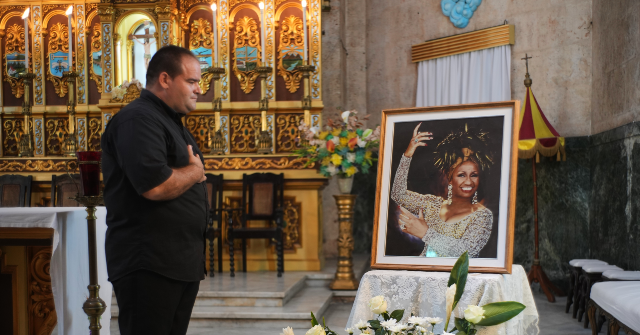The top American diplomat in Cuba, Embassy Charge d’Affairs Mike Hammer, was among hundreds who attended a Catholic Mass on Tuesday to honor what would have been the hundredth birthday of Celia Cruz, one of Cuba’s most iconic and beloved singers.
Cruz made her mark in the 1950s pre-Castro Cuban music scene, joining the longstanding Sonona Matancera. As part of that band, she was forced into exile in 1960, becoming a prominent and stalwart voice against communism around the world. Cruz would go on to find even greater international success, performing with the legendary Nuyorican salsa collective Fania All-Stars, and she enjoyed a career renaissance in the late 1990s and early 2000s with the hits “La Negra Tiene Tumbao” and “La Vida es un Carnaval.” She died in her adoptive New Jersey in 2003, having never again stepped foot inside Castro’s Cuba.
Cruz’s music and likeness was banned from Cuban television in radio throughout her entire career — and remains so today. An attempt to organize a musical homage to Cruz this week marking 100 years since her birth was abruptly canceled under political pressure. In defiance of that censorship, the Our Lady of Charity of El Cobre church in Central Havana organized a Mass on Tuesday for Cruz. Her music, shared clandestinely on the island, remains extremely popular, and reports indicate that hundreds of people attended the service. The ruling Communist Party, uncharacteristically, allowed the subdued religious service to occur without interruption.
Hammer, the top American government representative in the country, prayed alongside Cuban Catholics during the event.
“It is an honor to commemorate the life of Celia Cruz here, in her land,” Hammer said following the service, according to the local independent outlet 14 y Medio. “She wanted freedom for the Cuban people and that desire remains alive in her legacy.”
14 y Medio described a somber, but proud, atmosphere at the service. Parish priest Father Ariel Suárez addressed the political pressure, declaring, “Faith does not recognize censorship.” Cruz herself was Catholic and a devotee of Our Lady of Charity, the patroness saint of Cuba. Father Suárez noted that local artists requested the organizing of a Mass in her honor, a poignant symbol to them in the ongoing censorship of her music.
Cruz is one of the most visible and powerful symbols of Cuban anti-communist resistance in Cuban culture. Most of her songs did not include any overt political messaging, nor did she dedicate herself to singing explicitly against the regime. The few exceptions to her apolitical songs, for example, is the hit “Bemba Colorá,” a condemnation of racism in which the narrator in the song denigrates black people (in one famous improvised live version with the Fania All-Stars, Cruz adds lyrics urging domestic violence victims to fight back with a frying pan).
Cruz preferred to oppose the Castro regime with her life choices, actively denouncing the regime and refusing to return to Cuba if mass murderer Fidel Castro remained in power.
As the independent outlet Cubanet recalled this week, the regime punished Cruz by refusing to allow her to return the one time she tried — in 1962, to attend her mother’s funeral. Cruz ultimately returned to the island in 1990, but only to the U.S. military base in Guantánamo Bay to perform. The base allowed her to access the tallest part of American Cuba to be able to look out onto her homeland, and Cruz was seen taking dirt from the other side of a fence on the border of the base in a cup to take home.
Celia Cruz En Guantanamo
¡Azúcar! Vídeo histórico de la legendaria Celia Cruz, durante el viaje a la Base Naval estadounidense de Guantánamo en 1990, momentos donde Celia pisó la isla, pero no su patria. La artista tomó tierra “por debajo de la cerca con el deseo de que estuviera junto a ella cuando muriera, y así se hizo”. ➤ Creditos y Cortesía: Telemundo
Posted by Salsa Chimpum Callao on Tuesday, December 24, 2019
Her global popularity did not stop the Castro regime from banning her art on the island. Cubanet noted that her music remains outlawed today, as Cruz was on a blacklist of “traitor” artists who “allied with the enemy.” The outlet added that attempts by lower-ranking broadcast officials in Cuba to showcase Cruz throughout the years has resulted in significant political punishment. Cubans today nonetheless know her hits through sharing them clandestinely on flash drives.
In 2003, when Cruz died, the official Communist Party newspaper Granma acknowledged her passing but attacked her posthumously.
“Throughout the last four decades, she remained active systematically in campaigns against the Cuban Revolution generated from the United States, in which she was used as an icon by the counter-revolutionary enclave in southern Florida,” Granma accused, failing to acknowledge that she was not part of the Cuban-American community in Florida.
Charge d’Affairs Hammer’s presence at the Mass for Cruz is part of a larger effort that he has made to engage Cubans directly and to honor their true culture independent of the chains of communism. In September, for example, Hammer took the time to honor Our Lady of Charity on her feast day, congratulating Cubans on the occasion.
Hammer has made several trips throughout the island to meet with regular Cuban nationals independent of the regime’s watchful eye. As a result, the Communist Party has attempted to threaten him by sending thugs to record and menace him from close watch as he appeared in public. High-ranking communist officials have accused Hammer of “meddling and unfriendly conduct” and issued formal protests in response to his engagement with the Cuban people, a basic responsibility of any diplomat stationed abroad.
Follow Frances Martel on Facebook and Twitter.
Read the full article here



